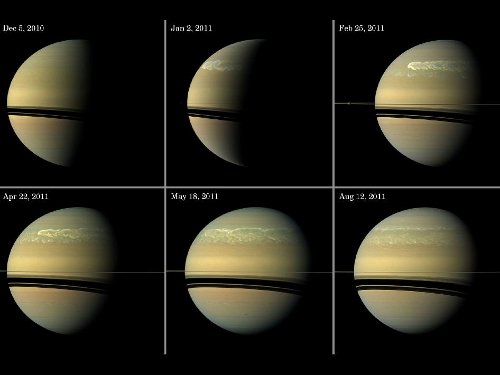Centauri Dreams
Imagining and Planning Interstellar Exploration
Reflections on a Mythic Voyager
Voyager 2 received commands in early November to switch to the backup set of thrusters that control the roll of the spacecraft. I keep close tabs on the Voyagers because, still operational, they constitute our first interstellar mission, headed beyond the heliosphere and still returning data. Launched in 1977, they’re an obvious example of long-term survival in space, an issue that will become increasingly visible as we plan for longer and deeper missions beyond our Solar System. We got word on November 5 that Voyager 2 has accepted the new commands.
Let’s talk about this first in terms of engineering. Behind the switch is the need to reduce operating power, for using the backup thruster pair that controls roll motion will let engineers turn off the heater that warms the fuel line to the primary thruster, saving about 12 watts of power. With Voyager 2’s power supply providing about 270 watts, finding savings like this can help the spacecraft remain operational. It’s remarkable to consider that the thrusters involved here have fired more than 318,000 times, while the backup pair has not yet been used in flight. Voyager 1 made a similar change in 2004 and is now using all three sets of its backup thrusters.
Sometimes when I read the relatively dry language of the status reports on Voyager my thoughts turn to ancient journeys that once defined out thinking. Pushing deep into the unknown evokes Homer to me, the journey of Odysseus and his crew on a ten year attempt to find their way home while running into all manner of mysteries, but of course there are mythic links to man’s innate urge to explore in many other cultures. Just making such connections seems like a romantic view of hard science, but why not? I just read Athena Andreadis’ short interview in SF Signal in which she talks about the uses of intuition in science, coupled with a ‘type of rigor and dedication usually associated with monastic orders.’ She goes on to liken scientists to wizards and ‘astrogators who never sleep,’ a direct nod to speculative fiction and its influence.
Andreadis knows all about hard science, of course. She’s a researcher in molecular neurobiology as well as being a cross-genre writer of considerable talent. We’re just coming off the Thanksgiving holiday here in the States and with the weekend approaching, I’m in a reflective mood anyway, so what Athena says about science has a fine resonance for me this morning, wrapping itself around the Voyager story and its interplay with the human need for journeying. Later in the interview, Charles Tan asked Andreadis whether the exploration of space was essential to the human future. The answer is a qualified yes, but one that takes into account our frequent over-estimation of our own destiny and the things we are capable of:
Space is inherently hostile to humans. People argue that humans have managed to overrun Earth and hence we can do the same beyond Earth, given advanced enough technology. However, we evolved here and even now, despite our technology, we are helpless before major planetary upheavals. The concept of going beyond our planet has a powerful hold on our imagination, for a good reason: we have a deep-rooted urge to explore, which is both a blessing and a curse. The challenges of crewed space expeditions are mind-boggling.
How true, and how often understated! But Andreadis believes in the attempt as part of that same urge for exploration that has seen ships embarking for ports unknown throughout our history:
Even so, I think it is indeed essential that we take to space at some point. Not for fortune or glory, but because we yearn for the next horizon. At the same time, we need to be deeply aware that we can never “conquer” space. The self-serving inanities of the Strong Anthropic Principle aside, triumphalism will avail us naught in a universe that is supremely indifferent to us and our aspirations.
In the poem ‘Mid-Journey,’ Andreadis writes in a way that calls up Homeric venturing and echoes (for me at least) Tennyson’s own Homeric reflections on getting older in ‘Ulysses’:
How plucked and gutted is our bright youth!
The gates of heaven stood open back then.
Now, fatigue and demons track our trail.
Within us and behind us, blood and darkness
And for those who loved us, ruins and flames.
Warmth and comfort are yokes for us.
We chose thorns, shoals and starlight.
We vowed ourselves irrevocably to battle.
We will die exiles, mercenaries to strangers,
Having seen and dreamed imperishable beauty.
You can hear the poem read aloud here. Stephen Pyne works nicely with the mythic nature of our spacecraft in his Voyager: Seeking Newer Worlds in the Third Great Age of Discovery (Viking, 2010), mindful of the need to relate what we do with science to the great themes of exploration as they have played themselves out in fact and in myth throughout history. We do well to remind ourselves, as Athena does, of both the rigor of science and the informed intuition that breeds the magic of discovery. I think about both, and about long voyages on wine-dark seas, when I imagine our Voyagers, still alive, being prepared for still deeper wanderings.

Ranking Exoplanet Habitability
Our notions of habitability are built around environments like our own, which is why the search for planets with temperatures that support liquid water at the surface is such a lively enterprise. But as we saw yesterday, it is not beyond possibility that many places in our Solar System could have sub-surface oceans, even remote objects in the Kuiper Belt. And that raises the question of how we assess astrobiological environments, an issue studied by Dirk Schulze-Makuch (Washington State University) and Abel Mendez (University of Puerto Rico at Arecibo), working with an international team of researchers in a paper suggesting a new approach.
Schulze-Makuch makes the situation clear:
“Habitability in a wider sense is not necessarily restricted to water as a solvent or to a planet circling a star. For example, the hydrocarbon lakes on Titan could host a different form of life. Analog studies in hydrocarbon environments on Earth, in fact, clearly indicate that these environments are habitable in principle. Orphan planets wandering free of any central star could likewise conceivably feature conditions suitable for some form of life.”
To avoid overlooking potentially habitable worlds as we discover more and more exoplanets, the authors propose two indices that help to provide a quantitative look at a given exoplanet’s chances for habitability. The first is an Earth Similarity Index that screens exoplanets in relation to all the factors that make our planet hospitable to life. The second is a Planetary Habitability Index, which describes chemical and physical parameters that may allow life to exist under conditions that vary markedly from Earth. Think Enceladus, or Europa. Think the exomoon of a gas giant. Think, in other words, as speculatively as possible.
The Planetary Habitability Index is based on ‘the presence of a stable substrate, available energy, appropriate chemistry, and the potential for holding a liquid solvent,’ as the paper’s abstract notes. But it’s also based upon hypotheses about life’s viability in extreme environments that we’re as yet unable to test. Acknowledging this, the authors see their index as an ongoing work that can be updated as technology and knowledge about astrobiology advances. Interestingly enough, they apply their metrics to the provocative Gliese 581 system, finding that both GJ 581c and GJ 581d show an Earth Similarity Index comparable to that of Mars, and a Planetary Habitability Index somewhere between that of Europa and Enceladus.
Future space instrumentation should be able to tell us whether an Earth-class planet shows the signature of life, but how do we use those instruments to size up an icy exomoon when we can’t make the call on far closer worlds like Europa? What will change the game is finding proof in our own Solar System that life can occur in just this kind of extreme environment. Such a demonstration would make the Planetary Habitability Index far more interesting — and accurate — telling us that life can adapt to places utterly unlike our own planet. Until that occurs, constructing the PHI seems like an intriguing but premature exercise.
The paper is Davila et al., “A Two-Tiered Approach to Assessing the Habitability of Exoplanets,” accepted by Astrobiology (abstract).

The Case for Pluto’s Ocean
Sub-surface oceans in the Solar System may be far more common than we’ve realized. We’ve grown used to contemplating water under the ice of Europa, but similar oceans may well exist on Ganymede and Callisto, and there are signs of a possible ocean beneath Titan, not to mention the unusual activity we continue to observe on Enceladus. Where liquid water in cold objects seems least likely is in the Kuiper Belt, but Guillaume Robuchon and Francis Nimmo (University of California at Santa Cruz) have been making the case for an ocean inside distant Pluto, based on their models of thermal evolution and the behavior of the ice shell.
As this article in Astrobiology Magazine points out (and thanks to my friend Antonio Tavani for the pointer to this one), Pluto’s outer surface is a thin shell of nitrogen ice covering a shell of water ice. With New Horizons inbound to Pluto/Charon for an April, 2015 encounter, the researchers have been working out what surface features might help us make the call on whether such an ocean exists. One possibility is an equatorial bulge left over from the earlier days of Pluto’s formation, when it would have been spinning more rapidly. Such a bulge would be perhaps 10 kilometers high if it exists and New Horizons should be able to see it. A bulge would indicate no ocean beneath, as movement of the liquid interior over time would have reduced the protrusion.
But tensional stresses as the shell was stretched when temperatures changed over the course of Pluto’s lifetime would imply water beneath, a different kind of feature than we would expect from a solid layer below. The good news is that while New Horizons is a flyby mission, it will be able to map the entire sunlit surface of Pluto beginning in the three months before closest approach — we should get highest resolution (62 meters per pixel) when New Horizons closes to 12,500 kilometers, and ridges, valleys and possible geyser features should be discernible.
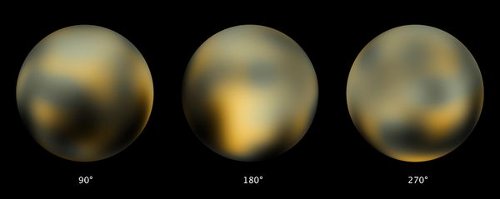
Image: Three Hubble images of Pluto. When New Horizons switches on its cameras three months before closest approach, even its most distant images of Pluto will be ten times more detailed than these. Credit: NASA, ESA, and M. Buie (Southwest Research Institute).
As to what would keep water liquid at an average 40 AU from the Sun:
The main source of energy likely stems from the rocky interior, where isotopes undergo radioactive decay. Among these elements, the researchers found potassium to be key – enough potassium in Pluto’s core would result in melted ice above it.
And signs look good – the amount of potassium needed would be about a tenth of that found in meteorites from the early solar system.
“I think there is a good chance that Pluto has enough potassium to maintain an ocean,” Nimmo said.
Robuchon and Nimmo calculate that a planet-wide ocean here would have an average depth of 165 kilometers beneath a crust of about the same thickness. Finding an ocean on Pluto would make the case for other Kuiper Belt oceans quite strong, especially on larger objects like Eris. A case for astrobiology in this extreme environment seems remote indeed, but the presence of an ocean here would remind us that the Kuiper Belt, which may contain a thousand dwarf planets or more, is likely to deal us surprises at every turn. And we can rejoice at the presence of New Horizons’ Long-Range Reconnaissance Imager (LORRI), which according to principal investigator Alan Stern, would be able to see individual buildings if flown over the Earth at New Horizons’ closest approach altitude. We are in for an incredible view in just a few years.

Notes & Queries 11/21/11
Millis on The Space Show
Marc Millis is now in Brussels for another TEDx talk — I link here to the TEDx description of him as ‘a rock star in the world of space geeks’ that always gives him a chuckle. More about the talk as soon as I have the link for online viewing. All this reminds me to tell you that Marc and I were guests on David Livingston’s The Space Show last week, with the MP3 now available at David’s site. Although we did kick around some interstellar propulsion concepts, particularly in the call-in segments, we spent most of the time talking about Tau Zero and the 100 Year Starship project. If you want to hear about the nuts and bolts of Tau Zero including the interesting and developing university affiliations, check out the two-hour podcast. David is a superb interviewer.
SF and the Sublime
Gregory Benford recently posted Peter Nicholls’ Big Dumb Objects and Cosmic Enigmas, a talk delivered in 1997 aboard the Queen Mary (now anchored at Long Beach, CA) on his site. Given the number of comments the recent science fiction discussion here has generated, it seems a good time to point to what Nicholls has to say. His ‘big dumb objects’ are vast alien artifacts, and he wants to relate them to what has always been called the ‘sense of wonder,’ a much abused term that describes our reaction to science fictional settings and situations. But let him describe what he’s about:
There is in science fiction, even or especially (as I will argue later) in so-called Hard science fiction, something which in other context we tend to think of as unscientific, be it called sense of wonder, or the sublime, or the transcendent as the Panshins have it, or the romantic. And one rather mechanical way of creating this effect is for the storyteller to imagine something very very big and mysterious, like the spaceship Rama, or like Larry Niven’s Ringworld. That is, the mysterious something in science fiction often has its locus classicus in the Big Dumb Object.
Now you can think of a lot of science fiction that fits this description, and Nicholls treats many of these titles, enough to give you a good holiday reading list and more. Gregory Benford’s Galactic Centre series is here, along with Bob Shaw’s Orbitsville and James Blish’s Cities in Flight. From Greg Bear (Eon, Eternity, Legacy) through Paul McAuley (Eternal Light) and Charles Sheffield (Summertide), he explores the tension between the familiar and the deeply strange ‘otherness’ of these tales, which becomes a kind of transcendence that transports the reader and opens up new ways of seeing the world. In the passage below, he contrasts his own reaction to such works with that of fellow editor John Clute, who worked with him on The Encyclopedia of Science Fiction (2nd ed., 1993 and now available in a beta 3rd edition online):
So we’re reaching a more sophisticated view of what space fiction in general and BDO fiction in particular tends to be about. It is about being dwarfed by space and hugeness, about attempting to maintain our own humanity, warts and all, in the light of this vastness, while at the same time yearning to be better or other than what we are. And this is not a theme that is intrinsically scientific at all, which makes it all the odder that it is in the hardest and most scientific sf that we tend to find the purest examples. I believe that what drives some of us to be scientists in the first place is an unusual openness to the sort of experience-or perhaps I should say the sort of feeling-that I’m clumsily and not very successfully trying to pin down. My own training is in both the sciences and the arts, though I should say the scientific bit in its formal manifestation was a long time ago. John Clute’s training is in the arts only. I’ve wondered at times whether my greater sympathy for certain kinds of science fiction, and my lesser sympathy for some other kinds, might not be a result of this early imprinting. I probably exaggerate.
I had never encountered Nicholls’ essay before and I commend it to you. He sees the writers of hard science fiction as not less but more romantic than their colleagues in ‘softer’ science fiction, finding the romantic element in the metaphors of deep space, which include the alien artifacts under consideration here. It’s certainly true that ‘big dumb objects’ — here I’m thinking specifically of Larry Niven’s star-encircling Ringworld, can so rattle our preconceptions that they do evoke that sense of the sublime that early 19th century writers and artists found in places like the Alps. Science fiction is not our only ticket to transcendence but the best of it does evoke the enigma of contact with things so far beyond ourselves that they partake equally of science and art.
Stormy Times on Saturn
Storms on gas giants are awe-inspiring events, as witness what has been happening on Saturn since December of 2010. For a year now a monster storm extending 15000 kilometers north to south has been pummelling the northern latitudes. The Cassini images below takes us back to the earliest trace of the storm on December 5, 2010 and follow it through the middle of 2011, with views acquired at distances ranging from 2.2 million kilometers to 3 million kilometers.
Image: This series of images from NASA’s Cassini spacecraft shows the development of the largest storm seen on the planet since 1990. These true-color and composite near-true-color views chronicle the storm from its start in late 2010 through mid-2011, showing how the distinct head of the storm quickly grew large but eventually became engulfed by the storm’s tail. Credit: NASA/JPL-Caltech/Space Science Institute.
This is the longest lasting storm of this kind ever seen on Saturn, and it’s a far cry from the kind of weather we see on Earth:
“The Saturn storm is more like a volcano than a terrestrial weather system,” said Andrew Ingersoll, a Cassini imaging team member at the California Institute of Technology in Pasadena. “The pressure builds up for many years before the storm erupts. The mystery is that there’s no rock to resist the pressure – to delay the eruption for so many years.”
What we’re learning about Saturn’s weather is that major storms come in outbursts separated by 20 to 30 years, which suggests a mechanism deep inside the planet that remains unknown. More in this CICLOPS news release.

Science Fiction and the Interstellar Idea
Science fiction has been much on my mind of late, particularly following the 100 Year Starship Symposium, where so many of the scientists I talked to mentioned novels and movies that had been influential in getting them into science. My friend Keith Cooper, editor of Astronomy Now and a fine science writer whose work I often cite in these pages, also shares an interest in SF, and it was natural enough that we fell into a conversation by email on how the genre relates to interstellar studies. Because while we would expect a natural synergy between science and science fiction, the genre’s cinematic and literary treatments are often at variance with each other. Why is this, and why are some elements of the interstellar idea easier to explore in writing than in film? Here are some thoughts (and memories) about science fiction’s role.
- Paul Gilster
Keith, you and I are both science fiction readers, although I’m enough old that I grew up in the heyday of Heinlein and all those great books for young people. I remember being in a book fair at my grade school where each class had tables set up with books that were considered appropriate for that grade level. I was in about third grade at the time, but I wandered over to the sixth grade table because I saw a hardcover copy of Heinlein’s Citizen of the Galaxy. I can still see that book’s cover, and feel the effect of that odd juxtaposition that Heinlein opened with — slavery in a far future society. At that point in my life, slavery was one of those things that were safely in the past, but of course Heinlein played with a lot of our expectations, as does SF in general.
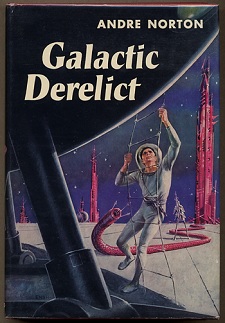
I could muse on some of those early readings for a long time, but the other one that really lit up for me was Starman Jones, in which I learned the term ‘astrogation’ and started to think seriously about ships that went between the stars. Right around the same time I found Andre Norton’s Galactic Derelict — can still recall the cover of that one, too, and the vistas it opened up to me. The list goes on and on, but maybe you can see why I’m sort of dismayed by the current emphasis on movie science fiction. In fact, when I mention SF to a lot of people, the response almost automatically refers to cinematic treatments. I’ve always enjoyed these but found them far less compelling than science fiction in actual books! But then, I’m a bit of a throwback. I still enjoy listening to old radio shows more than watching contemporary television programming.
I’d like to get your read on an idea that Geoff Landis told me about when I interviewed him for Centauri Dreams some years ago. We had been talking about his book of short stories called Impact Parameter and Other Quantum Realities, in which there is a story about an all-female crew on its way to Delta Pavonis. It’s a two-decade trip, as I recall, and conditions aboard the ship are cramped to the point of excruciation. How the crew finds the will and the mental fortitude to make it through the journey are what the Landis story is about, but it’s also a meditation on a key idea, that interstellar journeys may well be possible one day, but that they’re going to be long and hard under the best of circumstances.
But talk to the general public about star journeys and you basically get the same thing: Star Trek. I sometimes wonder whether science fiction as shown on television and in the movies hasn’t completely over-emphasized the far future possibilities at the expense of a more realistic approach. Wouldn’t it be interesting to tell the SF story — or make the SF movie — that tried to be as credible with the science as Destination Moon was when dealing with a lunar journey? I for one would love to see a movie version of the attempt to build an enormous sail for beamed propulsion, or someone’s read on a true Bussard ramscoop vessel. Hollywood is supposed to be where all the imagination is, so why have all the SF starships been so similar to each other?
- Keith Cooper

Paul, I think part of the problem is that in Hollywood they look at spacecraft the same way I look at cars: they go for an aesthetic but don’t really understand what goes on underneath the hood. I remember J Michael Straczynski once commenting that police officers, lawyers and doctors are hired to advise on police, courtroom or medical/forensic dramas, but they rarely use scientists or genre authors on science fiction shows or movies. I’d love to see a big budget movie featuring interstellar travel using nuclear fusion, microwave beaming and solar sails as advised by someone like Marc Millis or Kelvin Long.
Straczynski’s Babylon 5 was my favourite show as a teenager, and still is. He gave us a station that rotated to create the effect of gravity via centrifugal force, just like an O’Neill colony. The massive Earth cruisers had rotating mid-sections, and the Starfury fighters featured four-pronged vectored thrust multi-engines that NASA have optioned as a possible real-life design in the future. In contrast to B5’s alien spacecraft, the human spacecraft had well thought out designs and made space flight look a little more difficult than is usually portrayed on TV. This is a theme I want to pick up on.
Recently there appeared an article on the Tor website entitled A Moral Argument for Hard Science Fiction by Madeline Ashby. She talks about the inaccurate depiction of computers and computer hacking on the big screen, placing them in the broader context of the general lack of understanding of science amongst the public and politicians. To quote from her article:
“Me, I blame Hackers. I don’t mean actual hackers. I mean Hackers, the 1995 piece of bad William Gibson fan-fic about kids who save their haxx0r reputations with rollerblades and holograms. And with it I’d like to blame all other depictions of hacking as easy, technology as simple, and science as the work of solitary geniuses awaiting quick flashes of divine inspiration.”

If we substitute ‘interstellar travel’ for the word ‘hackers’ I fear the problem still stands. Space travel is part of the furniture of SF and we need it to voyage to wondrous new worlds, but at the same time it can seem too easy. I love Joe Haldeman’s The Forever War for showing that the consequences of relativistic space travel can be difficult for the characters as they return home from each mission finding that time on Earth has progressed without them.
However, written SF can gloss over the realities of building starships too. In Peter F Hamilton’s Commonwealth Saga, a human civilisation that has had wormhole technology for hundreds of years (railroads passing through wormholes link planets, which is ingenious) builds its first starship to investigate a Dyson Sphere. After they become embroiled in an interstellar war with the denizens of the Dyson Sphere, the Commonwealth quickly start building bigger, better and faster starships, seemingly at will. I adore Hamilton’s work but the process of building the new starships seemed too easy to me. E E ‘Doc’ Smith used to do the same thing in his Lensman series.
I’m now in a quandary Paul. I love to watch the adventures of Han Solo or Captain Kirk galivanting around the Galaxy, but at the same time I yearn for more science over fantasy. What examples of SF are there that strike the right balance and depict space travel as something that is hard but achievable with effort, while yet continuing to have exciting adventures on strange new worlds?
- Paul Gilster
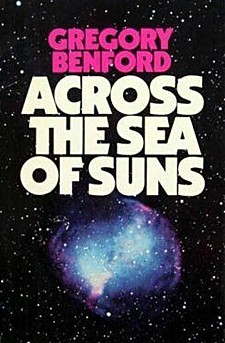
As I expected, Keith, we have many of the same enthusiasms. I do enjoy video treatments of science fiction but on a somewhat different level than written SF, but hey, I get a kick out of going back and reading old issues of Science Wonder and some of the early Astoundings as well. There’s something about that era and the way it interacted with the then current concept of the future that mesmerizes me. Anyway, we seem to be in a time when hard SF, with more emphasis on the science, is again competitive with the other strains of the genre. I am a great devotee of Gregory Benford’s work and think the Galactic Center series is the best treatment of the far future I’ve encountered. I have wonderful memories of the novella in IF back in 1972 that started it all off.
But maybe you’ve read Robert Forward’s Rocheworld, or the earlier, shorter work it was based on called Flight of the Dragonfly. Forward is one of my heroes for the insights he has given us into interstellar flight using known physics, but his fiction clanks a bit in terms of characterization even if the ideas he plays with are the kind of thing we discuss every day on Centauri Dreams. I’m betting laser sails and antimatter rocketry with a scrupulous attention to the physics are turning up in modern science fiction without my knowing it, because I’ve been so busy in the past ten years with the kind of work I’m doing now that I haven’t had the chance to keep pace with the field. We’re lucky here because the readers have always come up with book suggestions. Let’s see what they say.
Madeline Ashby makes sense to me, especially when she talks about depictions of hacking as “easy, technology as simple, and science as the work of solitary geniuses awaiting quick flashes of divine inspiration.” I don’t know about the hacking part because I’m not of the hacker mindset (though I envy people who hack in the true tradition of the world, meaning that they really get to understand how their computer and software work), but as far as science goes, when we depict the solitary geniuses waiting for inspiration, we’re not talking about a world that’s with us today. You look at major crowd-sourced projects like the Galaxy Zoo and realize how much science is being turned out by thousands of amateurs making a collaborative contribution. On the other end of the spectrum is something like the Large Hadron Collider, where vast numbers of highly-trained people turn up as co-authors on the papers generated by this enormous project.
The solitary inventor was the norm in Edison’s day, perhaps, but we see little of this today. I wouldn’t want to discourage anyone with a breakthrough idea, but we also need science fictional depictions of the way science works in today’s era of the particle accelerator and the federal grant. One of the things Greg Benford brings to the table is his intimate relationship with science through his own work in physics. He knows how the process works, where it is frustrating and where it can be exhilarating, and he’s done enough experimental physics to know how thorny are the problems of gaining the needed funding. But bear in mind that he and brother Jim have also found ways to test microwave beaming on a sail in a laboratory at relatively low cost, so this kind of thing does get done. I’d like to see more science fiction coming out of that kind of lab work.

As for movies, maybe James Cameron can be prevailed upon to try a different kind of starship one of these days. Or maybe Ridley Scott? Because if we’re talking movies, I’d love to see either of these men work up a screen treatment of Forward’s ideas in Rocheworld, taking a laser sail mission all the way to Barnard’s Star and solving the complex issues involved in deceleration and exploration. There’s a screen epic crying out to be made, and along the way it would introduce the general public to the concepts of interstellar flight by non-magical means.
Say, did you know that Isaac Asimov’s Foundation trilogy (I call it a trilogy because the next three novels came much later and I have to say I’m ambivalent about them) has been kicking around in the planning stages for one or another film studio for some years now? It would be fun to see what Hollywood made of it, but I’m a bit burned out with far future epics. Tell you what, let’s lobby for a beamed sail movie, and maybe also for Geoff Landis’ Mars Crossing to turn up in a movie version. We’d get two movies, one near-term, one much further out, each with an impeccable scientific pedigree. In the right hands, the results could be mesmerizing. How say you?
- Keith Cooper
Believe it or not Paul I’ve yet to read Benford, Landis or Forward; I’m well aware of their work but haven’t got around to them yet. Instead I’ve been ploughing through the ‘golden generation’ of UK SF authors from the past 20 years, such as Hamilton, Stephen Baxter, Alastair Reynolds, Richard Morgan, Iain Banks, Neal Asher and others. British SF currently has a lot going for it and I strongly recommend these authors to you. What I would say, however, is that among this clutch of British authors I think there is a tendency to focus more on world-building with lots of great plot ideas exploring a range of issues from the social to the cosmic, rather than any urge to delve too deeply into the mechanics of spaceflight. There are exceptions of course, such as Stephen Baxter, and although I don’t think there is much wrong with the current direction of UK SF, that pioneering spirit of space travel so evident in the novels you describe Paul does seem to be sometimes missing.
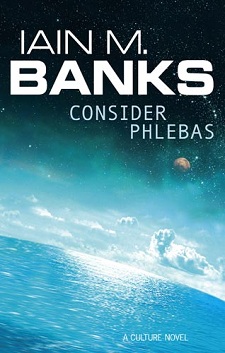
What strikes me about your description of Landis’ and Forward’s work makes me think they rather enjoyed doing the calculations to make their space travel realistic. Certainly it is no coincidence that the trio of authors you mention all have an academic science background, allowing them to reach the rigorous level of detail required to not only fully get to grips with the propulsion systems they deploy in their books, but also derive fresh new ideas.
We may ask, how many of the creative types in Hollywood are tuned into where SF is pushing the envelope today? So much of Hollywood’s output seems to be 20 or 30 years behind the current trends in written SF. Perhaps what is needed is for some SF authors to cross the divide. Robert Sawyer, for example, has done it somewhat on television with the likes of FlashForward, but let’s see more. I don’t know if it is a reluctance on the side of the authors, or whether Hollywood is a closed-shop, but rather than making movies based on books without the involvement of the authors, let’s see some SF authors team up with a director and be given the opportunity to write an original script for Hollywood.
I’m not sure who that director could be – the idea of a Foundation movie potentially helmed by Roland Emmerich fills me with dread, James Cameron’s Avatar was more fantasy than hard SF, and as great as Alien and Bladerunner are, Ridley Scott has not displayed any empathy for hard SF (although he has picked up the rights to The Forever War, which if done right could make for a tremendous film). Perhaps Ron Howard, with his experience on Apollo 13, might be a good choice, or some other up and coming director?
Science fiction is perhaps the first, best testbed for future technologies. In its pages we can play out where these technologies can take us, the riches they can give us and the risks they pose. To continue to do so, we need more scientists with a passion for the genre and an eloquence to their prose to introduce us to detailed new ideas. The authors who follow them can then be let loose with these concepts, like kids in a candy store, picking ideas off the shelf and running with them, placing them in new and exciting settings. This is how SF has always operated, from Stapledon to Clarke to Baxter, or Asimov to Niven to Banks to the next generation of authors – where will they take us next?
- Paul Gilster
PG: We can only imagine where they’ll take us next. I see we’re both in heavy reading mode. Lately I’ve been going back to some of the classics and refreshing my memory, most recently with Asimov’s first three Foundation books, which is why the subject was on my mind earlier. And I see you’re deep in the Hamiltons, Baxters and Reynolds of this world. What’s happened to me is that many of the readers of Centauri Dreams have suggested authors — this is how I started reading Alastair Reynolds and Iain Banks, and although I haven’t gotten into his work yet, I’ll use your suggestion (and I’ve heard it from others) to start reading Peter Hamilton.
I always get a kick out of learning about authors that are new to me, and you’ve mentioned several in this exchange that I’ll need to get to know. Interstellar flight has always gotten us straight into the science fiction element because there are so many unknowns, so many approaches, and we can let the concepts fly in fiction and see where they lead us. The number of physicists and engineers who have related what they are doing to earlier science fiction novels and short stories is, well, astounding, and tells us that SF will always play the role you describe, as testbed for both scientific ideas and philosophical speculations. Let’s keep the lines of communication open as we both discover new authors and range through their universes.

A Possible Subsurface Lake on Europa
An area of disrupted terrain called Thera Macula on Jupiter’s moon Europa may be evidence for a body of liquid water with the volume of North America’s Great Lakes encased within the ice. The notion comes from analysis of floating ice shelves that seem to be collapsing. That an ocean exists beneath the ice on Europa should surprise no one, but what is significant about the recent findings is that they suggest a way to exchange nutrients and energy between the surface and the ocean beneath. Such a mechanism changes the nature of the speculation about whether Europa’s ice is thick or thin. The case for astrobiology always seemed stronger if the ice were thin, but it seems that ways to exchange material with the surface may exist in either scenario.
At least that’s what this intriguing finding suggests. Britney Schmidt (University of Texas at Austin) is lead author on the paper that appears online in Nature:
“One opinion in the scientific community has been, ‘If the ice shell is thick, that’s bad for biology’ — that it might mean the surface isn’t communicating with the underlying ocean. Now we see evidence that it’s a thick ice shell that can mix vigorously, and new evidence for giant shallow lakes. That could make Europa and its ocean more habitable.”
When you work with Europa, you’re relying on images taken by the Galileo spacecraft, focusing in this case on two bumpy features in the disrupted topography that scientists call chaos terrain. The area known as Thera Macula shows evidence of active resurfacing of ice over a large body of water. Evidence that such terrain can still be forming is good news for those hopeful for life beneath the surface. The speculation is that many such lakes may exist throughout shallow regions of Europa’s shell, many of them covered with similar collapsing ice shelves.
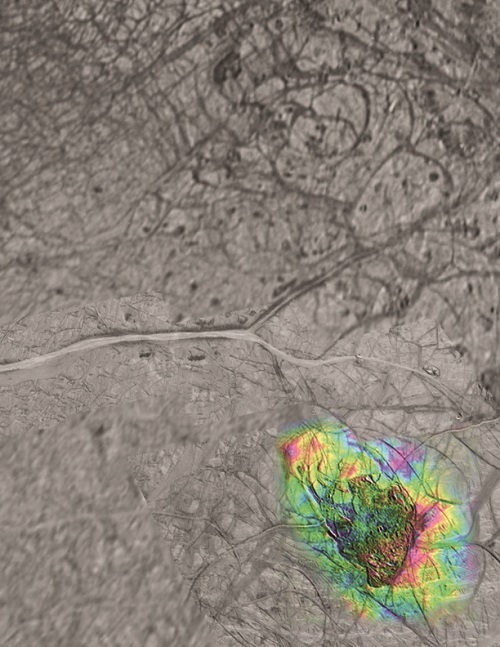
Image: Thera Macula (false color) is a region of likely active chaos production above a large liquid water lake in the icy shell of Europa. Color indicates topographic heights relative to background terrain. Purples and reds indicate the highest terrain. Credit: Paul Schenk/NASA.
The researchers worked with Galileo data and applied processes observed here on Earth in areas where ice shelves are in motion and volcanoes are found beneath overlying glaciers. Their work indicates that chaos terrains “… form above liquid water lenses perched within the ice shell as shallow as 3?kilometres. Our results suggest that ice–water interactions and freeze-out give rise to the diverse morphologies and topography of chaos terrains.” All of this means that nutrients and energy may be available in the deep ocean, but we won’t know for sure until we can develop a mission that is designed to probe beneath the ice. The same kind of radar instruments that study Earth features within ice can be adapted for such a spacecraft.
The paper is Schmidt et al., “Active formation of ‘chaos terrain’ over shallow subsurface water on Europa,” published online in Nature 16 November 2011 (abstract).

